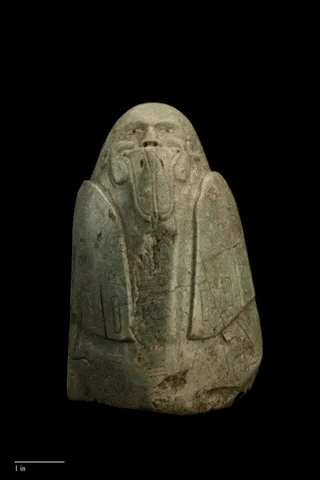What Secrets Does This 1,800-Year-Old Carved Stone Hold?
The Tuxtla Statuette illuminates an endangered Latin American culture
/https://tf-cmsv2-smithsonianmag-media.s3.amazonaws.com/filer/7b/ae/7baeec46-42ce-4a2f-8d3b-ef4de2c9a8b7/oct2021_e02_prologue-final.jpg)
In 1902, an Indigenous man plowing a field near the Tuxtla Mountains in the state of Veracruz, Mexico, unearthed a green stone the size of a large mango—a piece of jadeite with carvings depicting a stout human figure with a shamanic bird’s bill. Along its sides was a set of hieroglyphs.
Before long, the Tuxtla Statuette (as it became known) made its way to the United States, and in 1903 to the Smithsonian. At first, archaeologists thought the statuette’s markings were Mayan; southern Mexico rests within the heart of the Mayan civilization, where Mayan dialects are still spoken today. But one observer felt unsure. Charles Pickering Bowditch—a Boston businessman, philanthropist and scholar of Mesoamerica who served on the faculty at Harvard’s Peabody Museum—compared the hieroglyphs with a card catalog he had assembled of all the Mayan characters then available. “I cannot find any real likeness between the two kinds of glyphs,” he wrote in 1907. Bowditch argued that the statuette carried an unknown indigenous language—one with no clear relative. In the 1960s, scholars hypothesized that it was “epi-Olmec,” a late language of the Olmec people, the most ancient known Mesoamerican civilization, which predated the height of Mayan civilization by about 1,000 years. This hypothesis is still subject to debate.
In 1993, John Justeson and Terrence Kaufman, both linguists, offered a possible solution to the mystery. Aided by the handful of objects with the same script unearthed since Bowditch’s day, they put forward a translation—the first modern reading, they said, of epi-Olmec. Further, Justeson and Kaufman’s translation of the glyphs seemed to reveal the statuette’s age. Chemical dating was not helpful; sampling the object’s substrate would simply give the age of the stone, not of the carvings. The two scholars held that the writing, in its entirety, gives a year in epi-Olmec—specifically A.D. 162, dating it to the middle period of epi-Olmec society.
Surviving examples of epi-Olmec are exceedingly rare; only 12 known objects bear its script. Given this paucity of evidence, some scholars argue that Justeson and Kaufman can’t claim to have translated the language until more artifacts come to light; others even say that calling the script “epi-Olmec” is premature. Yet Justeson and Kaufman’s translation has helped scholars decode other known objects that carry legible epi-Olmec. In 2019, Kaufman and Justeson persuasively argued that a poem on one artifact, which in their translation describes the transit of Venus, corresponds to past astronomical events. Fascinatingly, their reading displays strong similarities with the present-day languages of the Mixe and Zoquean peoples of southern Mexico. If the translation is accurate, it suggests that the epi-Olmecs spoke a form of Zoquean, a branch of the Mixe-Zoquean family. It also suggests that a descendant of the epi-Olmec language is still spoken today. Accordingly, the Tuxtla Statuette was crucial in helping to elucidate a previously inscrutable ancient language—and connecting modern indigenous cultures to a linguistic past once thought to be lost.

It makes sense that epi-Olmec would survive in modern languages. Jane Walsh, a Smithsonian anthropologist emerita, notes that the Olmecs are considered by many to be “the mother culture” of various subsequent Mesoamerican civilizations from southern Mexico to Costa Rica. Indeed, anyone who has eaten a taco has enjoyed their legacy: The Olmecs were among the first to mix corn with limewater, a critical step in Nixtamalization, the process of making tortillas.
The Mexican government officially recognizes 68 indigenous languages within its borders, spoken by millions of people. Yet after surviving centuries of colonization and Spanish-speaking dominance, many of these languages, including Mixe and Zoquean, are critically endangered. Yásnaya Elena Aguilar Gil, an indigenous Ayuujk writer and linguist from Mexico and a native Mixe speaker, has written poignantly about efforts to keep indigenous Mexican languages alive, in what she calls a “struggle for linguistic rights.” Across Mexico, indigenous people are campaigning for public schools to teach indigenous languages.
Today, in Justeson and Kaufman’s account, the Tuxtla Statuette is a keystone in that struggle. Imagine that a small statuette was one of only a few known objects where the Latin language survived. That artifact would become priceless for anyone studying the history of modern tongues descended from Latin, such as Spanish, Italian and French. The Tuxtla Statuette is a holdover of a sophisticated culture that endured conquest and assimilation—a heritage that indigenous people are fighting to keep alive.